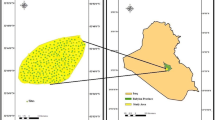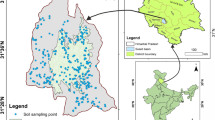Abstract
There is a considerable lack of essential information about Entisols derived from shale in the arid desert environment. This study was thus carried out to characterize and map the spatial variability of primary properties of Entisols in Dakhla Oasis, Western Desert, Egypt. Soil properties of twenty-seven profiles represented by Entisols were carefully examined. Geostatistical analysis was performed to map soil variability based on the ordinary kriging interpolation method. Results show that most of the studied soils (92.1%) were fine and medium in texture. The values of electrical conductivity of soil paste extract (ECe) ranged between 0.45 and 36.40 dS m−1 (mean = 10.35 dS m−1). Most of the studied soil samples (82.9%) were extremely low in organic matter (OM) (≤ 3.4 g kg−1). The cation exchange capacity (CEC) ranged between 9.37 and 50.84 cmol(+) kg−1 with an average of 29.09 cmol(+) kg−1. The coefficient of variation was high to very high for sand, ECe, and OM; moderate for silt, clay, saturation percentage, and CEC; and low for the soil pH. Significantly positive and negative correlations were observed among the Entisol properties (at P < 0.01 and/or P < 0.05), and most of these relationships are likely associated with the parent material. Precise maps created efficiently with geostatistics were crucial for a proper understanding of the current spatial variability in the study area. This study provides valuable information and new knowledge about the properties and the spatial variability of this type of Entisols.






Similar content being viewed by others
Change history
21 July 2020
The original version of this paper was published with error. Figure 3 were corrected into Figs. 3 and 4, but the old titles were used for these two figures and the updated captions which author sent in the last modification of the images were not used. Given in this article are the correct captions.
References
Abu Seif ES, Abd Al-Aziz EM (2008) Geotechnical factors affecting undrained shear strength of Quseir Shale in Dakhla Oasis, Western Desert, Egypt. Faculty of Engineering, Assiut University. J Eng Sci 36:131–145
Ageeb GW (1999) Comprehensive investigation of the soils formed on shale deposits in Egypt. Cairo University, Dissertation
Ahmad AS (1976) Origin and forms of iron and their effect on physico-chemical properties in Egypt. Dissertation, Cairo University
Atya I (2014) Land evaluation and sustainable development of some areas of Dakhla Oasis, Egypt. Dissertation, Cairo University
Beaumont P (1993) Climate and hydrology. In: Graig GM (ed) The agriculture of Egypt. Oxford University Press, New York, pp 16–38
Black CA (1982) Methods of soil analysis. 2nd edn. Chemical and microbiological properties. Agronomy series no. 9, ASA, SSSA, Madison
Bockheim JG, Hartemink AE (2017) The soils of Wisconsin. Springer, Berlin, p 292
ESRI (Environmental Systems Research Institute) (2014) ArcMap version 10.2.2 user manual. ESRI: Redlands
Gee GW, Bauder JW (1986) Particle-size analysis. In: Klute A (ed) Methods of soil analysis. Part 1. 2nd edn. Agron, Monogr, vol 9. ASA and SSSA, Madison, pp 383–411
Gringarten E, Deutsch CV (2001) Teacher’s aide variogram interpretation and modeling. Math Geol 33:507–534
Grossman RB (1983) Entisols. In: Wilding LP, Smeck NE, Hall GF (eds) Pedogenesis and soil taxonomy 11. Soil orders, developments in soil science 11B. Elsevier Pub., Co., Amsterdam, pp 55–90
Hamdi H, Abdelhafez S (2001) Agriculture and soil survey in Egypt. In: Zdruli P, Steduto P, Lacirignola C, Montanarella L, editors. Soil resources of Southern and Eastern Mediterranean countries. Bari: CIHEAM (Options Méditerranéennes: Series B. Etudes et Recherches; n. 34). pp. 111–130. http://om.ciheam.org/om/pdf/b34/01002089.pdf
Harga AA (1977) Soils of Kharga and Dakhla oases: I. Geomorphology and classification of some representative profiles. Desert Inst Bull, A.R.E., 72
Hartemink AE, Bockheim JG (2013) Soil genesis and classification. Catena. 104:251–256. https://doi.org/10.1016/j.catena.2012.12.001
Hassan AA, Mustafa MA (2018) Assessment and mapping of wind erodibility of Aridisols and Entisols in the Nile State, Sudan. Sudan Journal of Desertification Research 3(1)
Henning D, Flohn H (1977) Climate aridity index map. United Nations Conference on Desertification. UNEP, Nairobi, Kenya
Hermina M (1990) The surroundings of Kharga, Dakhla and Farafra oases. In: Said R (ed) The geology of Egypt. Balkema, Rotterdam, pp 259–292
Hermina M, Ghabrial MG, Issawi B (1961) The geology of the Dakhla area, Egypt. Geological Survey and Mineral Research Department, Cairo 11:35
Hussein AM (1993) Characterization of some soil families in Dakhla Oasis. Al-Azhar Journal of Agricultural Research 18: 339–352
Isaaks EH, Srivastava RM (1989) An introduction to applied geostatistics. Oxford University Press, New York
Jabro JD, Stevens WB, Evans RG, Iversen WM (2010) Spatial variability and correlation of selected soil properties in the AP horizon of CRP Grassland. Appl Eng Agric 26:419–428. https://doi.org/10.13031/2013.29957
Jackson ML (1973) Soil chemical analysis. Prentice Hall, New Delhi
Johnston K, Hoef JM, Krivoruchko K, Lucas N (2001) Using ArcGIS Geostatistical Analyst. ESRI, Redlands
Kaya E, Agca M, Adiguzel F, Cetin M (2019) Spatial data analysis with R programming for environment. Human and Ecological Risk Assessment: An International J 25(6):1521–1530. https://doi.org/. https://doi.org/10.1080/10807039.2018.1470896
Nielsen DR, Bouma J (1985) Soil spatial variability. Wageningen: Pudoc:2–30
Rahman KU, Subramanian R, Shahid SA, Ismail S (2019) Rootzone salinity monitoring and management in Acacia ampliceps irrigated with three water salinity levels in Entisols of United Arab Emirates. J Agric Crop Res 7(4):55–63
Rasheed MA, Wahab MA, Youssef RA (2010) Digital geopedological mapping of some study areas in western desert, Egypt. J Am Sci 6(9):23–29
Richards LA (1954) Diagnosis and improvement of saline and alkali soils. Agricultural handbook, no. 60. USDA, Washington, D.C., p 160
Said R (1990) The geology of Egypt. Balkema, Rotterdam
Sarangi A, Cox CA, Madramootoo CA (2005) Geostatistical methods for prediction of spatial variability of rainfall in a mountainous region. Trans ASAE 48:943–954. https://doi.org/10.13031/2013.18507
Sefelnasr A, Gossel W, Wycisk P (2014) Three-dimensional groundwater flow modeling approach for the groundwater management options for the Dakhla Oasis, Western Desert, Egypt. Environ Earth Sci. 72(4):1227–1241. https://doi.org/10.1007/s12665-013-3041-4
Selmy SAH (2005) Studies on some shale-derived soils in the New Valley, Egypt. Dissertation, Assiut University
Shepard C, Schaap MG, Crimmins MA, van Leeuwen WJ, Rasmussen C (2015) Subsurface soil textural control of aboveground productivity in the US Desert Southwest. Geoderma Regional 4:44–54
Soil Survey Staff (2014) Keys to soil taxonomy, 12th edn. USDA-Natural Resources Conservation Service, Washington, DC
Stein ML (1999) Interpolation of spatial data: some theory for kriging. Springer, New York
UNEP (United Nations Environment Programme) (1997) World atlas of desertification. 2nd edition. In: Middleton N, Thomas D (eds) Arnold. London and Wiley, New York
Vieira SR, Hatfield JL, Nielsen DR, Biggar JW (1983) Geostatistical theory and application to variability of some agronomical properties. Hilgardia. 51(3):1–75. https://doi.org/10.3733/hilg.v51n03p075
Wilding LP (1985) Spatial variability: its documentation, accommodation, and implication to soil surveys. In: Nielsen DR, Bouma J (eds) Soil spatial variability. Pudoc, Wageningen, pp 166–194
Wycisk P (1987) Contributions to the subsurface geology of the Misaha Trough and southern Dakhla Basin (S. Egypt/N. Sudan). Berliner Geowiss Abh. (A) 75: 137–150
Wycisk P (1993) Outline of the geology and mineral resources of the southern Dakhla Basin, southwest Egypt. In: Meissner B, Wycisk P, editors. Geopotential and ecology: analysis of a desert region. Catena, Supplement, 26. pp. 67–89. https://www.unikoeln.de/sfb389/sonstiges/kroepelin/280%201993%20CatenaSuppl%20web.pdf
Wycisk P (1994) Correlation of the major late Jurassic —Early Tertiary low- and highstand cycles of south-west Egypt and north-west Sudan. Geol Rundsch, 83(4): 759–772. https://link.springer.com/content/pdf/10.1007%2FBF00251074.pdf
Yamamoto JK (2000) An alternative measure of the reliability of ordinary kriging estimates. Math Geol 32(4):489–450. https://doi.org/10.1023/2FA%3A1007577916868.pdf
Author information
Authors and Affiliations
Corresponding author
Additional information
Responsible Editor: Stefan Grab
The original version of this article was revised: Figure 3 were corrected into Figs 3 and 4, but the old titles were used for these two figures and the updated captions which author sent in the last modification of the images were not used. Given in this article are the correct captions.
Highlights
• We investigated the characteristics of Entisols derived from shale in arid desert environment.
• This study provides important information about properties of this type of soils, which has a severe lack of information.
• Geostatistical analyses provide powerful analytical tools to capture the horizontal variability of soil properties.
• The coefficient of variation (CV) is a useful indicator for spatial and vertical variations of soil properties.
• The parent material plays an effective role in the diversity of soil properties in the arid regions.
Rights and permissions
About this article
Cite this article
Selmy, S., Abd El-Aziz, S., Gameh, M. et al. Characterization and mapping spatial variability of Entisols derived from shale in Dakhla Oasis, Egypt. Arab J Geosci 13, 592 (2020). https://doi.org/10.1007/s12517-020-05540-2
Received:
Accepted:
Published:
DOI: https://doi.org/10.1007/s12517-020-05540-2




